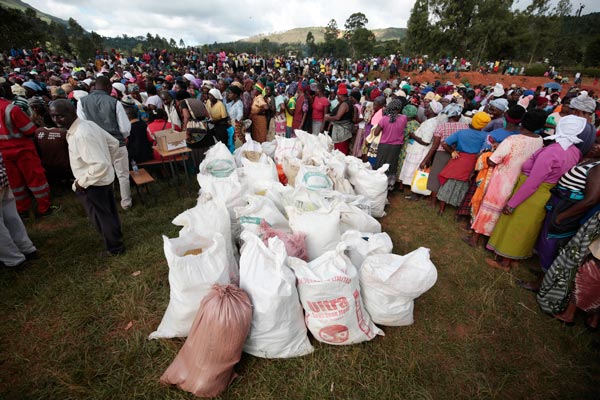

News in depth BY EVERSON MUSHAVA/ TAPIWA ZIVIRA
It was like a journey to the unknown as we meandered up and down the mountains.
We had left our vehicle several kilometres behind, as it became apparent that despite having high clearance and four-wheel drive capacity, it could not take us to our destination, Rusitu Valley, as the roads are impassable.
On the way, we met locals who told us heartrending takes of the devastation that Cyclone Idai had caused across the entire community, with Rusitu Valley being cited as the worst hit.
Our legs ached from the walk, but we had to plod on.
We hoped for the best for the people of that area, but the stories we had heard so far had us expecting the worst.
Our mission was to tell the full story because we felt it only been partially told, as the areas hit by the cyclone had remained inaccessible.
Scores of people were walking in the same direction as us, with some of them saying they were going to look for their relatives.
- Chamisa under fire over US$120K donation
- Mavhunga puts DeMbare into Chibuku quarterfinals
- Pension funds bet on Cabora Bassa oilfields
- Councils defy govt fire tender directive
Keep Reading
“I just want to see where my sister’s son and his family perished. That’s all,” one of them said.
All the walking was beginning to take a toll on our bodies and we thought of giving up, but just as we were about to do so, the Rusitu Valley came into sight.
We were relieved, but at the same time shocked and heartbroken.
What we saw was a bed of white rocks, sand, mud, rubble, destroyed buildings and debris scattered over a vast area that people told us was once a buzzing rural service centre. Only a few buildings on the western side remained intact.
As we trudged further down into the valley, sweaty and anxious, we came face to face with the extent of the damage the cyclone had caused here.
As we were later told, the area, which is low-lying and has three rivers running one each side, had become a confluence point, as the riverbanks had burst, spilling water onto the flat area that was occupied by the shopping centre.

The force of the rivers, Rusitu, Nyahode and Chipita, submerged an entire suburb, washing away people, houses and cars, depositing huge boulders whose source is still a mystery. We put on our sweat-drenched shirts that we had tied around our waists for the better part of the journey.
The excitement to be among the first group of journalists to brave the terrain to get the story soon died down, and in its place, fear and emotions crept in.
The crowd was swirling at Kopa after news broke that President Emmerson Mnangagwa would be visiting the place.
On their faces were etched stories of anxiety and fear of what the future held.
“This place had close to 80 houses, all the people were washed away,” Dudzai Ndiyadzo, a headman in the area, said.
“The flood water washed away this whole residential area, destroying over 80 houses.
“Hundreds of people are still missing five days after the storm.
“They could be buried under the huge stones deposited by the floods.
“We hope rescue teams will come in and recover the bodies.”
We looked at the huge boulders in disbelief.
What he was saying did not make sense to us.
Sensing our shock, Ndiyadzo continued: “Most of the rocks and the debris were carried by Nyahode River.
“You see, what happened is that, the three rivers — Rusitu, Nyahode and Chipita — used to meet downstream and this suburb was in the middle.
“But on this day, some bridges up stream along Rusitu and Nyahode trapped some debris and blocked water, forcing it to change course.
“When the bridges gave in, the huge mass of water accumulating at the bridges drowned the whole suburb.
“There were about 80 houses, mainly for agriculture extension workers, Agriculture and Rural Development Authority employees and a few other private individuals who also had their own houses.
“There was also Gata Police Station and what is left of it is that board that used to be a signpost.
“There were many people in this suburb, including schoolchildren from various places lodging here attending school at Ndima High School.
“They all perished.”
Although five days had passed since the floods, Joice Mudzokora, still hoped this was a nightmare that she would wake out of.
“Very few people survived.
“We were marooned and some men tied a rope on a window at the police station, which people used to cross over.
“I survived with all my children, but most people did not make it.
“Many people were washed away. It was traumatising,” she said.
“After the water levels had subsided, some families went through the debris looking for their relatives.
“We found one kid in the debris.
“We saw hands in the sand and called the men to dig up and recovered the body of the child.”
With tears trickling down her cheeks, she added: “All these rocks were not here; not even the small ones.
“This was a nice place.”
Majiva Magweva (32) still could not explain how she survived the floods that claimed her two children, her niece and mother.
“It was around 9pm on Friday when water started flooding our house.
“I took my two-year-old child and went outside to look for a secure place,” she narrated.
“I walked a few steps and was knocked down. I tried hard to keep a tight grip on my child, but was hit by a rock on the chest and was forced to let go of the child.
“I was thrown onto the river bank and I realised I was marooned, as the water levels kept rising.
“I saw another woman.
“We rushed and helped each other up a tree, pushing and pulling each other.
“Another woman came and we climbed up a tree.
“We were all naked; we had been stripped naked by the floods.”
Magweva said help only came almost 18 hours later and during that time, they had remained perched up in the tree — praying.
“Around 3pm on Saturday, rescue came, but in a very difficult way.
“A group of men came with ropes, but these were too short.
“One of them volunteered to have a rope tied around his waist and he dived into the water, while the others held the rope to ensure he did not drown.
“He got to the tree and rescued us,” she said with tears streaming down her cheeks.
After they had been rescued, Magweva says that is when she realised the scale of the disaster.
Rescue teams are still battling to recover bodies, with some suspected to have been washed away into Mozambique.
“Many people died.
“Some cannot even be identified because they were traders who did not stay here.
“There was a banana market and the place is also filled with gold panners, with buyers coming in and out of this area.
“Most of them were trapped and died,” one villager, who only identified himself as Sithole, said.
“My neighbour, who worked at Agritex and lived alone while his wife stayed with the kids in Masvingo where she worked, had invited his family for the weekend.
“He had four children.
“They were all swept away except the wife.”










